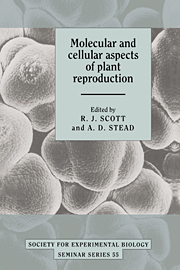Book contents
- Frontmatter
- Contents
- List of Contributors
- Introduction: ‘Where do we go from here?’
- Molecular control of floral organogenesis and plant reproduction in Petunia hybrida
- Control of floral morphogenesis in cauliflower (Brassica oleracea L. var. botrytis): the role of homeotic genes
- Isolation and properties of mutants of Arabidopsis thaliana with reduced sensitivity to short days
- Asexual mutants in Melandrium album (Silene alba): tools in cDNA cloning and analysis of an X/Y chromosome system in plants
- Pollen exine – the sporopollenin enigma and the physics of pattern
- The diversity and regulation of gene expression in the pathway of male gametophyte development
- Characterisation of Arabidopsis thaliana anther-specific gene which shares sequence similarity with β-1,3-glucanases
- Ovule cDNA clones of Petunia hybrida encoding proteins homologous to MAP and shaggy/zeste-white 3 protein kinases
- Towards the elucidation of the mechanisms of pollen tube inhibition during the self-incompatibility response in Papaver rhoeas
- Intracellular movement and pollen physiology: progress and prospects
- Organisation and functions of cell surface molecules on gametes of the brown algae Fucus
- Strategies of flower senescence – a review
- The physiology of petal senescence which is not initiated by ethylene
- Molecular biology of flower senescence in carnation
- Ethylene sensitivity and flower senescence
- Ethylene biosynthetic genes and inter-organ signalling during flower senescence
- Index
Ethylene biosynthetic genes and inter-organ signalling during flower senescence
Published online by Cambridge University Press: 04 August 2010
- Frontmatter
- Contents
- List of Contributors
- Introduction: ‘Where do we go from here?’
- Molecular control of floral organogenesis and plant reproduction in Petunia hybrida
- Control of floral morphogenesis in cauliflower (Brassica oleracea L. var. botrytis): the role of homeotic genes
- Isolation and properties of mutants of Arabidopsis thaliana with reduced sensitivity to short days
- Asexual mutants in Melandrium album (Silene alba): tools in cDNA cloning and analysis of an X/Y chromosome system in plants
- Pollen exine – the sporopollenin enigma and the physics of pattern
- The diversity and regulation of gene expression in the pathway of male gametophyte development
- Characterisation of Arabidopsis thaliana anther-specific gene which shares sequence similarity with β-1,3-glucanases
- Ovule cDNA clones of Petunia hybrida encoding proteins homologous to MAP and shaggy/zeste-white 3 protein kinases
- Towards the elucidation of the mechanisms of pollen tube inhibition during the self-incompatibility response in Papaver rhoeas
- Intracellular movement and pollen physiology: progress and prospects
- Organisation and functions of cell surface molecules on gametes of the brown algae Fucus
- Strategies of flower senescence – a review
- The physiology of petal senescence which is not initiated by ethylene
- Molecular biology of flower senescence in carnation
- Ethylene sensitivity and flower senescence
- Ethylene biosynthetic genes and inter-organ signalling during flower senescence
- Index
Summary
Systems for inter-organ communication
In order to successfully survive, all living organisms require a system to respond to the continuously changing environment, and to regulate the various developmental processes in cells and organs at different locations in the body. The following discussion highlights the communication systems in plants with special emphasis on reproductive aspects.
In animals, two major systems are involved in inter-organ communication, i.e. the nervous system and the hormone system. In addition, the immune system uses different classes of chemical messengers (e.g. interleukins, interferons, nitric oxide) to coordinate the defence response (Norman & Litwack, 1987; Roitt, Brostaff & Male, 1993). Although the metabolism of individual plant and animal cells may show many similarities, there is no a priori reason why the mechanisms, involved in the responses to environmental cues and in communication between different organs should in any way be the same. However, systems showing some similarities to the animal nervous system have been found in plants. For instance, mechanisms have evolved to respond within seconds to mechanical perturbation in Drosera (sundew) and Mimosa pudica. The movements of the leaves of Mimosa pudica are regulated by motor organs (pulvini) and are the result of turgor variations in the cortical (motor) cells of these organs. It has been shown that ionic migration, in particular of K+ and C1−, appears in the pulvinus, concomitant with the turgor changes (Satter & Galston, 1981; Fleurat-Lessard et al., 1988).
- Type
- Chapter
- Information
- Molecular and Cellular Aspects of Plant Reproduction , pp. 285 - 308Publisher: Cambridge University PressPrint publication year: 1994
- 10
- Cited by



